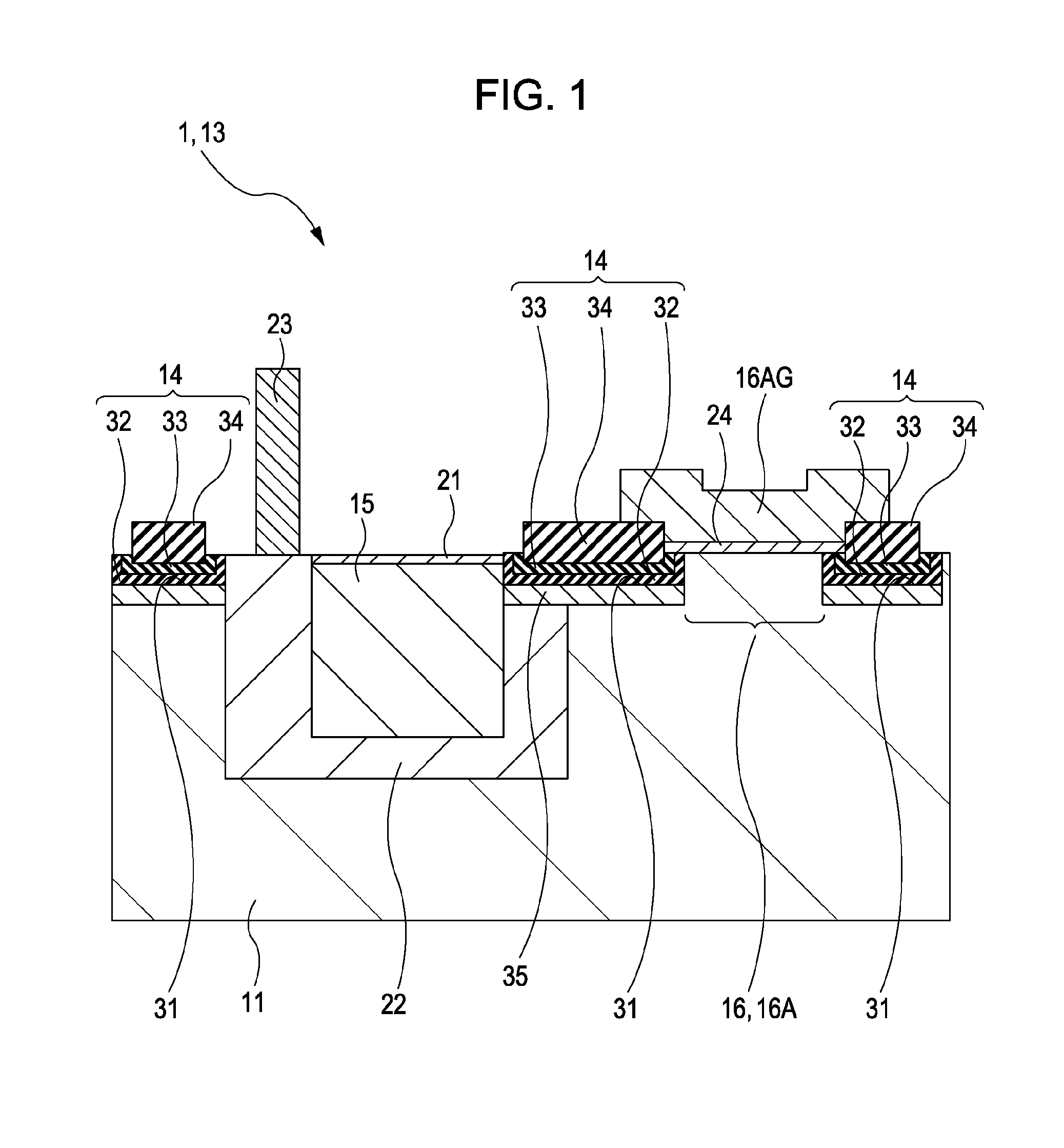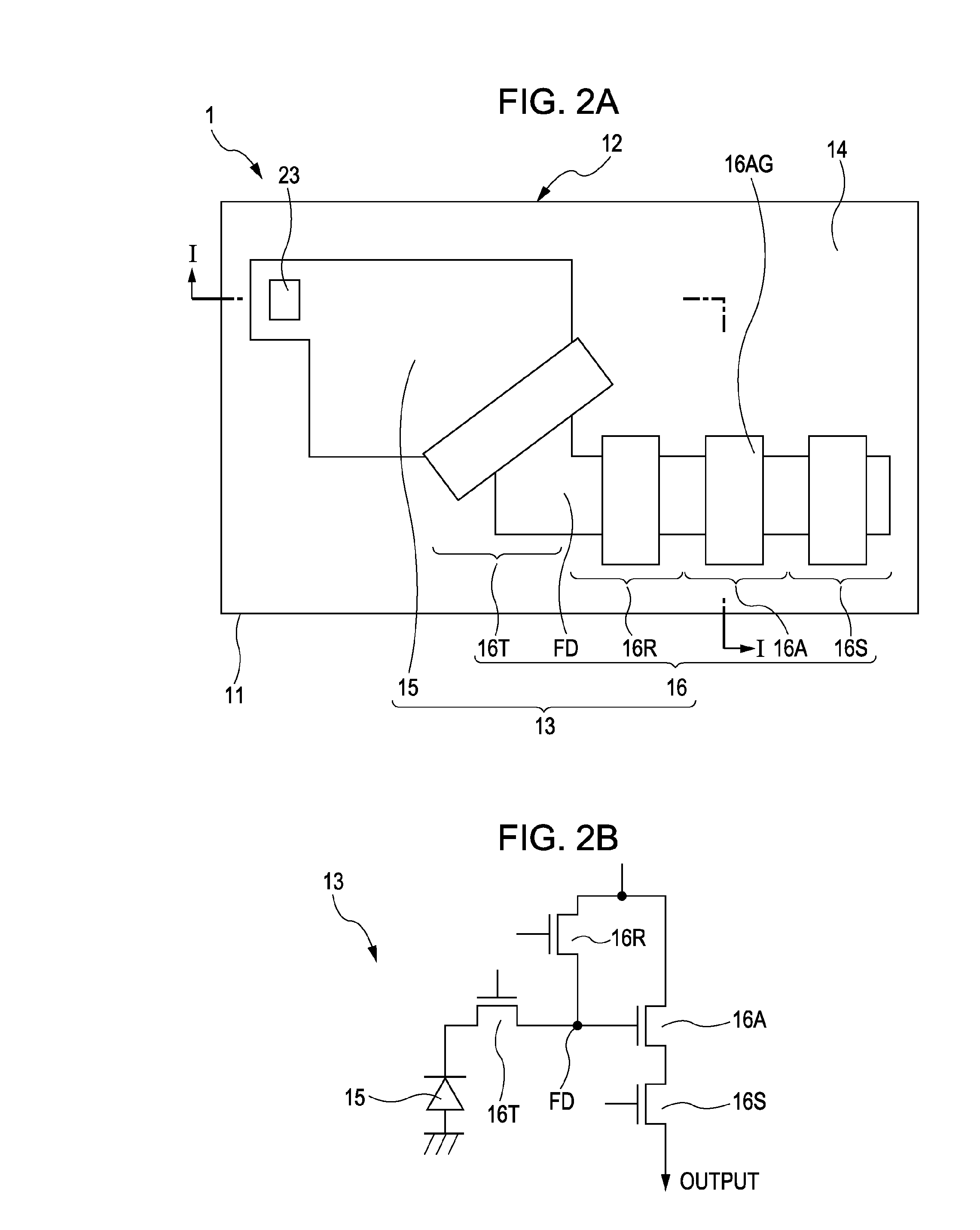Solid-state imaging device, method for manufacturing solid-state imaging device, and imaging apparatus
a solid-state imaging and imaging device technology, applied in the direction of color television, television system, radio control device, etc., can solve the problems of difficult compatibility between noise reduction and finer pixels, 1/f noise of pixel transistors, etc., to reduce the effective channel width reduce the effect of pixel size and reduced 1/f noise of the transistor in the pixel transistor portion
- Summary
- Abstract
- Description
- Claims
- Application Information
AI Technical Summary
Benefits of technology
Problems solved by technology
Method used
Image
Examples
first embodiment
[0040]One Example of Configuration of Solid-State Imaging Device
[0041]One example of the configuration of a solid-state imaging device according to a first embodiment of the present invention will be described with reference to a schematic configuration sectional view shown in FIG. 1, a plane layout diagram shown in FIG. 2A, and a circuit diagram shown in FIG. 2B. FIG. 1 is a diagram schematically showing a section taken along a line I-I shown in FIG. 2A.
[0042]As shown in FIGS. 2A and 2B, a solid-state imaging device 1 according to an embodiment of the present invention includes a pixel portion 12, in which a plurality of pixels 13 (one typical pixel is shown in the drawing) are arranged on a semiconductor substrate 11, and a peripheral circuit portion (not shown in the drawing) disposed in the periphery of the pixel portion 12. Furthermore, the above-described pixel portion 12 includes element isolation regions 14 to isolate individual pixels 13. Moreover, the above-described pixel...
second embodiment
[0072]First Example of Method for Manufacturing Solid-State Imaging Device
[0073]A first example of a method for manufacturing a solid-state imaging device, according to a second embodiment of the present invention, will be described with reference to sectional views of production steps shown in FIG. 3A to FIG. 4E.
[0074]As shown in FIG. 3A, a silicon oxide film 71 and a silicon nitride film 72 are formed sequentially on a semiconductor substrate 11. For example, a silicon substrate is used for the above-described semiconductor substrate 11.
[0075]Then, as shown in FIG. 3B, a resist mask (not shown in the drawing) for forming element isolation trenches is formed on the above-described silicon nitride film 72. The resulting mask is used as an etching mask and the above-described silicon nitride film 72, the above-described silicon oxide film 71, and the above-described semiconductor substrate 11 are etched. That is, a first trench 51 for element isolation is formed in a pixel region 17 ...
third embodiment
[0115]Second Example of Method for Manufacturing Solid-State Imaging Device
[0116]A second example of a method for manufacturing a solid-state imaging device, according to a third embodiment of the present invention, will be described with reference to sectional views of production steps shown in FIG. 5A to FIG. 6F.
[0117]As shown in FIG. 5A, a silicon oxide film 71 and a silicon nitride film 72 are formed sequentially on a semiconductor substrate 11. For example, a silicon substrate is used for the above-described semiconductor substrate 11.
[0118]As shown in FIG. 5B, a resist mask (not shown in the drawing) for forming element isolation trenches on the above-described silicon nitride film 72 is formed. The resulting mask is used as an etching mask and the above-described silicon nitride film 72, the above-described silicon oxide film 71, and the above-described semiconductor substrate 11 are etched. That is, a first trench 51 for element isolation is formed in a pixel region 17 of th...
PUM
 Login to View More
Login to View More Abstract
Description
Claims
Application Information
 Login to View More
Login to View More - R&D
- Intellectual Property
- Life Sciences
- Materials
- Tech Scout
- Unparalleled Data Quality
- Higher Quality Content
- 60% Fewer Hallucinations
Browse by: Latest US Patents, China's latest patents, Technical Efficacy Thesaurus, Application Domain, Technology Topic, Popular Technical Reports.
© 2025 PatSnap. All rights reserved.Legal|Privacy policy|Modern Slavery Act Transparency Statement|Sitemap|About US| Contact US: help@patsnap.com



